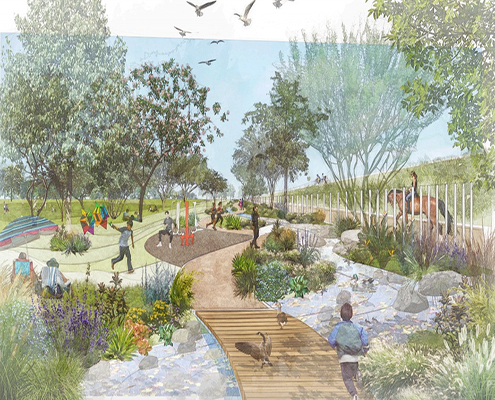Los Angeles County is investing billions of dollars from voter-approved Measures W, H, A, and M in clean, safe water; housing and homeless services; parks and open space; transportation; and climate resilience. Expected to generate more than $1.6 billion a year, these four measures are referred to as WHAM. State and federal stimulus efforts will likely mean even more funding is on the way.
“WHAM is a fitting acronym for investments that could have transformative impact, especially in the county’s most disadvantaged communities that have not benefited equitably from infrastructure investments in the past and have been hardest hit by COVD-19,” said Jon Christensen, co-author of the report and adjunct assistant professor in the Luskin Center for Innovation and the Institute of the Environment and Sustainability at UCLA.
Recognizing the tremendous potential, the Board of Supervisors set up a task force to institutionalize collaboration amongst the county agencies on multi-benefit WHAM projects. Such projects would combine parks and open space, stormwater management and green infrastructure, transportation, housing, workforce development, job creation, and climate resilience. The Board then endorsed a community-driven process that identified implementable projects in each of the county’s five supervisorial districts. But implementation remains elusive.
“Overcoming the barriers addressed in our report would create investment pathways to meet the most pressing needs of Angelenos in an equitable and efficient way,” said Christensen.
The co-authors recommend that the County Board of Supervisors:
- Direct county agencies to collaborate on implementing one multi-benefit pilot project in each supervisorial district as a short-term, first step.
- Encourage the Board of the L.A. County Metropolitan Transportation Agency (Metro) to adopt the WHAM Taskforce’s goals and work plan.
- Direct the County’s Chief Sustainability Office to form a strike team to identify and solve impediments to collaboration and convene a multi-agency and stakeholder learning community.
- Fund community engagement to inform the pilot projects.
- Fund an independent evaluation of WHAM implementation to learn, improve, and ensure success.
The report also recommends that the philanthropic community:
- Fund an independent legal review to identify legal impediments to interagency collaborative funding and implementation of multibenefit projects as well as opportunities for improvements in integrated implementation.
- Continue to fund community-based organizations and nonprofits to develop and expand their own research, technical, and advocacy capacities to engage in developing multi-benefit projects.

